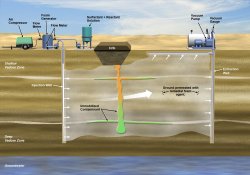Remedial Strategies
Effective in situ remedial strategies capable of treating low permeability regions in vadose zone environments
Delivery of amendments within vadose zone environments is a challenging and critical aspect for all remedy-based remediation approaches. The conventional approach for amendment delivery is through injection or infiltration of chemical solutions. However, delivery of remedial solutions through a heterogeneous deep vadose zone environment encounters hydrologic and geochemical challenges.
First, because the flow of solution infiltration is dominantly controlled by gravity and suction, preferential flow paths of the solution in the deep vadose zone are very difficult to overcome. Injected liquid preferentially percolates through the high permeability (high-k) pathways at high infiltration rates potentially bypassing low-permeability (low-k) zones, which may contain the majority of contamination. Generally, vertical migration is observed through high-k zones and lateral migration observed deeper in the low-k zones of the vadose zone.
Second, the wetting front of a water-based delivery can readily mobilize contaminants with high mobility retained in the vadose zone sediments. Once the pore water is mobilized by the injected solution, it moves downwards to the aquifer. This potentially enhances contaminant transport to the underlying aquifer before it interacts with the amendment.
Foam is a dispersed phase of gas in a liquid. In contrast to solution flow in water-based delivery systems, foam flow under vadose zone conditions is not dominated by gravity; rather, it can be directed by pressure gradients in the sediments. This allows resolution of uneven remedial fluid distribution in heterogeneous, subsurface environments. Furthermore, the use of foam also provides better control on the volume of fluid (~ < 20% vol.) required for remedy delivery and emplacement thereby minimizing the potential for contaminant mobilization.

